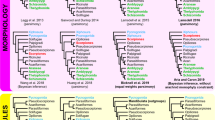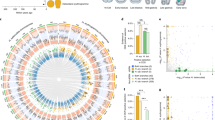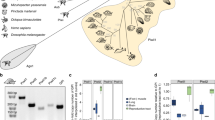Abstract
The mechanisms by which gene expression patterns emerge during evolution are poorly understood. The sea urchin spec genes offer a useful means to investigate evolutionary mechanisms. Genes of the spec family from Strongylocentrotus purpuratus and Lytechinus pictus have identical patterns of aboral ectoderm-specific expression but exhibit species-specific differences in copy number, genomic structure, temporal expression, and cis-regulatory architecture. Here, we identify spec genes from a phylogenetic intermediate, Strongylocentrotus franciscanus, to gain insight into the evolution of the spec gene family and its transcriptional regulation. We identified two spec genes in the S. franciscanus genome, sfspec1a and sfspec1b, that were orthologous to spec1 from S. purpuratus. sfspec1b transcripts began to accumulate at the blastula stage and became progressively more abundant; this was reminiscent of spec expression in L. pictus but different from that in S. purpuratus. As expected, sfspec1b expression was restricted to aboral ectoderm cells. The six-exon structure of the sfspec1b genomic locus was identical to that of the S. purpuratus spec genes and was bounded by two repeat–spacer–repeat (RSR) repetitive sequence elements, which are conserved features of S. purpuratus spec genes and function as transcriptional enhancers. The enhancer activity of the sfspec1b RSRs was comparable to that of their S. purpuratus counterparts, although the placement and orientation of crucial cis-regulatory elements within the RSRs differed. We discovered a spec gene in S. franciscanus that was only distantly related to other spec genes but was highly conserved in S. purpuratus. Unexpectedly, this gene was expressed exclusively in endoderm lineages. Our results show that the evolution of spec cis-regulatory elements is highly dynamic and that substantial alterations can occur when maintaining or grossly modifying gene expression patterns.








Similar content being viewed by others
References
Akasaka K, Nishimura A, Hijikata K, Iuchi Y, Morokuma J, Takahashi M, Morikawa H, Shimada H (1995) Introduction of DNA into sea urchin eggs by particle gun. Mol Mar Biol Biotechnol 4:255–261
Angerer LM, Oleksyn DW, Levine AM, Li X, Klein, WH, Angerer RC (2001) Sea urchin goosecoid function links fate specification along the animal-vegetal and oral–aboral axis. Development 128:4393–4404
Brandhorst BP, Klein WH (1992) Territorial specification and control of gene expression in the sea urchin embryo. Semin Dev Biol 3:175–186
Brandhorst BP, Klein WH (2002) Molecular patterning along the sea urchin animal–vegetal axis. Int Rev Cytol 213:183–232
Britten RJ, Davidson EH (1969) Gene regulation for higher cells: a theory. Science 165:349–357
Carpenter CD, Bruskin AM, Hardin PE, Keast MJ, Anstrom J, Tyner AL, Brandhorst BP, Klein WH (1983) Novel proteins belonging to the troponin C superfamily are encoded by set of mRNAs in sea urchin embryos. Cell 36:663–671
Dayal S, Kiyama T, Villinski JT, Zhang N, Liang S, Klein WH (2004) Creation of cis-regulatory elements during sea urchin evolution by co-option and optimization of a repetitive sequence adjacent to the spec2a gene. Dev Biol 273:436–453
Fang H, Brandhorst BP (1994) Evolution of actin gene families of sea urchins. J Mol Evol 39:347–356
Gan L, Klein WH (1993) A positive cis-regulatory element with a bicoid target site lies within the sea urchin spec2a enhancer. Dev Biol 157:119–132
Gan L, Wessel GM, Klein WH (1990a) Regulatory elements from the related spec genes of Strongylocentrotus purpuratus yield different spatial patterns with a lacZ reporter gene. Dev Biol 142:346–359
Gan L, Zhang W, Klein WH (1990b) Repetitive DNA sequences linked to the sea urchin spec genes contain transcriptional enhancer-like elements. Dev Biol 139:186–196
Gan L, Mao CA, Wikramanayake A, Angerer LM, Angerer RC, Klein WH (1995) An orthodenticle-related protein from Strongylocentrotus purpuratus. Dev Biol 167:517–528
Hardin SH, Carpenter CD, Hardin PE, Bruskin AM, Klein WH (1985) Structure of the spec1 gene encoding a major calcium-binding protein in the embryonic ectoderm of the sea urchin, Strongylocentrotus purpuratus. J Mol Biol 186:243–255
Hardin PE, Angerer LM, Hardin SH, Angerer RC, Klein WH (1988) Spec2 genes of Strongylocentrotus purpuratus. Structure and differential expression in embryonic aboral ectoderm cells. J Mol Biol 202:417–431
Howard ML, Davidson EH (2004) cis-regulatory circuits in development. Dev Biol 271:109–118
Kissenger JC, Raff RA (1998) Evolutionary changes in sites and timing of actin gene expression in embryos of the direct and indirect developing sea urchins, Heliocidaris erythrogramma and H. tuberculata. Dev Genes Evol 208:82–93
Kiyama T, Zhang N, Dayal S, Lee PY, Liang S, Villinski JT, Klein WH (2005) Strongylocentrotus purpuratus transcription factor GATA-E binds to and represses transcription at an Otx-Goosecoid cis-regulatory element within the aboral ectoderm-specific spec2a enhancer. Dev Biol 280:436–447
Klein WH, Hardin SH, Brandhorst BP (1987) Spec proteins: calcium-binding proteins in the embryonic ectoderm cells of sea urchins. Methods Enzymol 139:354–363
Klein WH, Xiang M, Wessel GM (1991) Spec proteins: calcium-binding proteins in the embryonic ectoderm cells of sea urchins. In: CW Heizmann (ed) Novel calcium binding proteins: structures, principles and chemical relevance. Springer, Berlin Heidelberg New York, pp 465–479
Kumar S, Tamura K, Jakobsen IB, Nei M (2001) MEGA2: molecular evolutionary genetics analysis software. Bioinformatics 17:1244–1245
Lee YH (2003) Molecular phylogenies and divergence times of sea urchin species of Strongylocentrotidae, Echinoida. Mol Biol Evol 20:1211–1221
Li X, Chuang CK, Mao CA, Angerer LM, Klein WH (1997) Two Otx proteins generated from multiple transcripts of a single gene in Strongylocentrotus purpuratus. Dev Biol 187:253–266
Li X, Bhattacharya C, Dayal S, Maity S, Klein WH (2002) Ectoderm gene activation in sea urchin embryos mediated by CCAAT-binding factor. Differentiation 70:109–119
Littlewood DT, Smith AB (1995) A combined morphological and molecular phylogeny for sea urchins (Echinoidea: Echinodermata). Philos Trans R Soc Lond B Biol Sci 347:213–234
Mao CA, Gan L, Klein WH (1994) Multiple Otx binding sites required for expression of the Strongylocentrotus purpuratus spec2a gene. Dev Biol 165:229–242
Mao CA, Wikramanayake AH, Gan L, Chuang CK, Summers RG, Klein WH (1996) Altering cell fates in sea urchin embryos by overexpressing SpOtx, an orthodenticle-related protein. Development 122:1489–1498
Ransick A, Rast JP, Minokawa T, Calestani C, Davidson EH (2002) New early zygotic regulators expressed in endomesoderm of sea urchin embryos discovered by differential array hybridization. Dev Biol 246:132–147
Shoguchi E, Tokuoka M, Kominami T (2002) In situ screening for genes expressed preferentially in secondary mesenchyme cells of sea urchin embryos. Dev Genes Evol 212:407–418
Tomlinson CR, Klein WH (1990) Temporal and spatial transcriptional regulation of the aboral ectoderm-specific spec genes during sea urchin embryogenesis. Mol Reprod Dev 25:328–338
Xiang MQ, Bedard PA, Wessel G, Filion M, Brandhorst BP, Klein WH (1988) Tandem duplication and divergence of a sea urchin protein belonging to the troponin C superfamily. J Biol Chem 263:173–180
Xiang MQ, Ge T, Tomlinson CR, Klein WH (1991) Structure and promoter activity of the LpS1 genes of Lytechinus pictus. Duplicated exons account for LpS1 proteins with eight calcium binding domains. J Biol Chem 266:10524–10533
Yuh CH, Li X, Davidson EH, Klein WH (2001) Correct expression of spec2a in the sea urchin embryo requires both Otx and other cis-regulatory elements. Dev Biol 232:424–438
Acknowledgements
We thank George Weinstock, codirector of the Human Genome Sequencing Center at Baylor College of Medicine for his generous assistance in sequencing S. franciscanus genomic clones. This work was supported by National Institute of Child Health and Human Development (NICHD) grant HD22619 to W.H.K. and by the Robert A. Welch Foundation (Endowed Chair G-0010). J.T.V. and S.D. were supported in part by an NICHD pre- and postdoctoral training grant (HD07325). The University of Texas M.D. Anderson Cancer Center DNA Analysis Facility is supported in part by National Institute of Cancer grant CA16672.
Author information
Authors and Affiliations
Corresponding author
Additional information
Communicated by M. Q. Martindale
Rights and permissions
About this article
Cite this article
Villinski, J.T., Kiyama, T., Dayal, S. et al. Structure, expression, and transcriptional regulation of the Strongylocentrotus franciscanus spec gene family encoding intracellular calcium-binding proteins. Dev Genes Evol 215, 410–422 (2005). https://doi.org/10.1007/s00427-005-0489-6
Received:
Accepted:
Published:
Issue Date:
DOI: https://doi.org/10.1007/s00427-005-0489-6




